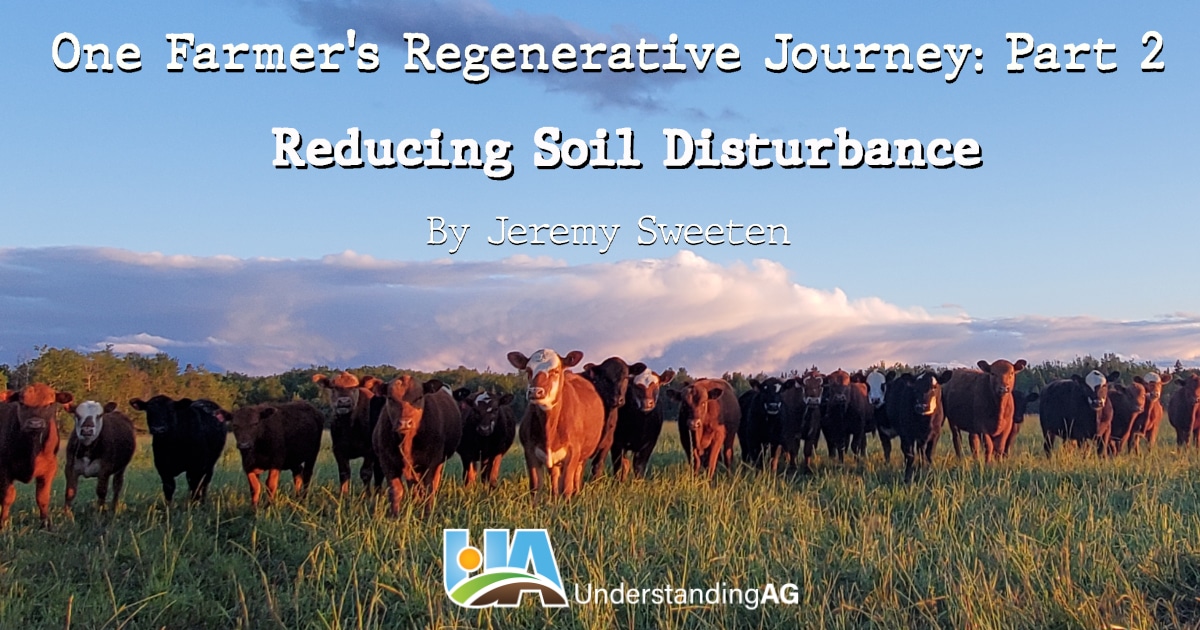
Reducing soil disturbance is the second rule of the Six Principles of Soil Health™. Tillage and other deep disturbances destroy the structure of the soil, plant roots, the mycorrhizae fungi and ultimately the overall soil biome. Tillage also allows organic matter to be oxidized, all of which adds up to a decline in soil resiliency. This reduced resiliency may not show up as much in a “normal” year but throw in a drought or wet year and the impact of degraded soil becomes very apparent.
For the past 40 years, our farm was in a hay, pasture and cereal grain rotation. Corn and soybeans will grow here sporadically; however, wet falls or an early freeze usually prevent harvest. Soil drainage on flat, clay soils with a high-water table is a challenge and our soil structure is poor because Timothy and trefoil have shallow root systems. Local practices included moldboard plowing to reseed perennial hay fields and as part of the plowing procedure, it is common to place drainage furrows with a plow on 30-60-feet centers. At first, I thought this was what I needed to do. What I found was the first year following the plow, the new crop looked great, but I now realize that this was the result of a release of carbon from the soil propping up the new seeding. In year two and three there was a slump in yield, plant health and almost no soil aggregation.
With a move away from tillage, I am now seeing an increase in plant diversity, soil health and increased soil support for cattle and equipment. Adaptive grazing and positive animal impact have improved soil aggregation and respiration. The results show improved water infiltration and water holding capacity of the soil. As the soil’s aggregation improves, there is no need for systematic drainage furrows. The soil ecosystem fixes itself if you treat it correctly. We do not yet have a no-till drill, so we use a conventional drill for overseeding pastures or seeding annual cover crops. Eliminating 95% of the tillage has reduced fuel usage and freed up a significant amount of time.
The cattle that are so much of a positive impact on soil health can also destroy a healthy, well-functioning soil in just a few hours, if improperly managed. Screw ups happen. For example, when it rains and when cattle don’t get moved soon enough and tractors and wagons leave ruts, or hay feeding in the fall/spring pugs up an area, all of which can cause soil damage. Time heals wounds inflicted upon the soil and it is always interesting to see what plants come back after a paddock gets pugged up by livestock. We try to give damaged areas an extended time of rest (adaptive grazing hint here) to allow plants and biology to regrow above and below the soil surface.
Occasionally, an area becomes too rough, and we smooth it with a light disking, which provides a great opportunity to add annual cover crops into the rotation. The usual harvest method for these areas is grazing, but only if the ground conditions permit. There is an abundance of seed in the soil seed bank that usually germinates underneath the annual cover crop.
On our family’s regenerative journey, our goal is to improve soil aggregation and structure to fix the water cycle. This seems simplistic, but a well-structured soil supports livestock, infiltrates water and grows outstanding pasture. Not disturbing the soil and armoring the soil go hand in hand in achieving that goal. I will discuss how we have improved soil armor in the next article.
